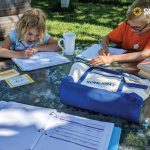
If you’re anything like me, back to school is an exciting time of year. The sun is shining, the kids are still happy and carefree, and I am gleefully hidden amongst piles of books and Instructor’s Guides. It’s one of my favorite times of the year. Very little thrills me more than cracking open new books on Box Day and pondering the possibilities of a new school year.
There’s only one thing that bogs me down—organization. It’s particularly challenging when I have kids in multiple Sonlight programs. How do I organize these glorious stacks of homeschool books, schedules, and papers?
The really interesting part about all of this is that I’ve never organized things the same way in all my years of homeschooling. Each year brings its own challenges, and every year requires at least a small tweak of my organization system. However, there are a few organizing tips that I’ve found to stand the test of time. Pick and choose from these five systems for organizing multiple levels of Sonlight.
Continue reading below or listen here:
1. Plan For the Year with 36 File Folders
Sonlight makes planning for the year a breeze. I use the Crate System, made popular by Kristi Clover and used by homeschoolers across the land. It’s easy. I fill a crate full of 36 hanging files. Then, I assign each of my kids 36 colored file folders, one per week. I file all their activity pages in those files.
Even workbooks such as Explode the Code go in there. Yes, I do tear them apart. I know it’s hard to do, but it’s worth it to be able to just pull out the file each week. I even throw in a page for their Spelling pretest and posttest. This allows me to have little to no prep time on weekends during the school year. The weekly file folders also enable my kids to immediately begin their work without having to wait for me to hand them their activity pages.
2. Make Yourself a Teacher Crate
I love the big, sturdy Sonlight binder just as much as anyone else, but when you have three separate binders, it gets cumbersome to lug out each binder every single week. So, I set up a crate for myself. I set up thirty-six hanging files to hold one week of Instructor’s Guides for every level my kids are using for the year.
It’s a real sanity-saver to be able to pull out all your Instructor’s Guide pages at one time. Then, at the beginning of the week, I take the Instructor’s Guide pages out of the file folder and put them into a smaller binder with dividers so I can quickly find the section I need. At the end of the year, I have my most administrative-minded child file all the schedules back in their place in the Sonlight binder.
3. Use Assignment Books
Each year, I buy inexpensive student assignment books for each of my school age children. Each week, on Friday afternoon, I sit down with my Instructor’s Guide and write out all their assignments for the week. This practice has transformed our school days. It has enabled my kids to become more independent and more accountable, and has freed up my mind through the week.
4. Discover the Bliss of the Compendium
It sounds complicated, but the compendium is actually a very simple spiral notebook that my kids use for every subject. It’s the place where they do all their “loose" paperwork. A spelling, writing, or even a math assignment can be completed in the compendium.
On the very front page, we write a table of contents. Then, we number all the pages of the spiral notebook. When they complete an assignment in their compendium, they simply write the page number and the assignment on their custom table of contents. This system makes finding assignments super simple.
Grading is so much easier with this system, too, because I never have to go searching for a “loose paper” assignment. I know exactly where they are, and I can even keep track of what I’ve graded using a red check mark next to the assignment in the table of contents.
5. Set Up a Portfolio
The final system that I’ve found to be a lifesaver is the portfolio system. Many states require a portfolio anyway, and I’ve discovered that filing the papers directly into the portfolio instead of waiting until the end of the year makes a big difference! Our portfolios consist of a large 3-ring binder and a set of dividers. We write each subject on a divider, and on Friday afternoons, they put all their graded work into the appropriate place in the binder. I also include any rubrics or progress reports they may have. At the end of the year, I get to breathe a huge sigh of relief, because there is no mountain of unorganized papers to painstakingly sort through.
With just a little bit of planning, you can set up your Sonlight year for success, even with multiple levels! You’ll be glad you took the time to prepare your year when the middle of February rolls around. There’s still time no matter where you are in your school year, so grab some coffee and a snack, and start organizing your multiple levels of Sonlight!
If you need advice about managing multiple programs or teaching multiple children together, we have experienced homeschooling moms who would love to talk to you. Click here to connect with your homeschool consultant.









I would love to see a video of this system. I'm just starting out with sonlight, and I'm not sure how to approach it with multiple children in multiple levels.
I'm more of a visual learner so I'm struggling to see how this system is set up, but it sounds very promising.
Thank you for sharing.
I am now copying the grid pages for each of my kids instead of spending time writing out the assignments. Because I would always fall behind.
Thanks so much for the shout out! If folks are interested in learning more about my crate system, they can find my course at HomeschoolOrganization.com. So happy to hear that you are using my crate and finding success with it!
Blessings and joy,
Kristi Clover
KristiClover.com
This is so helpful - thank you!
Wow! This is super brilliant! Way to go, Deana!